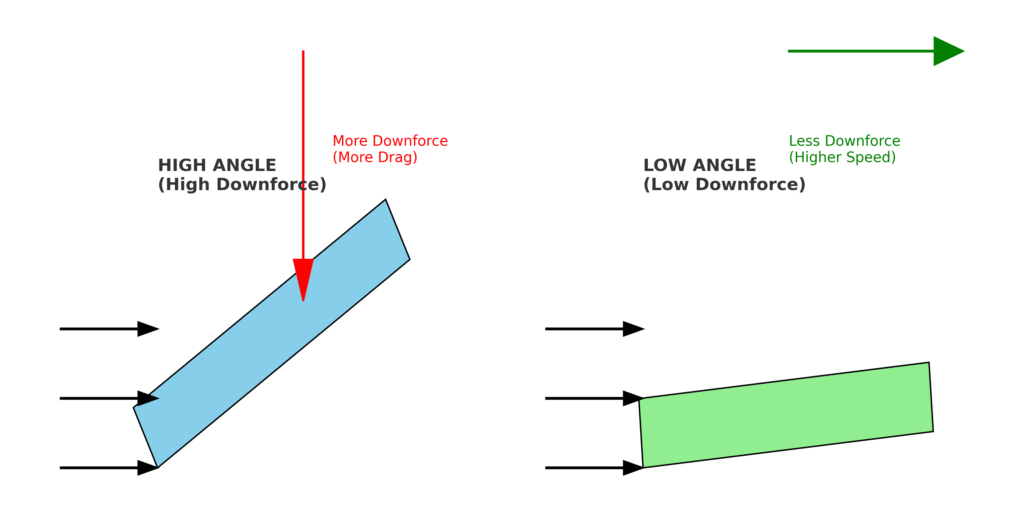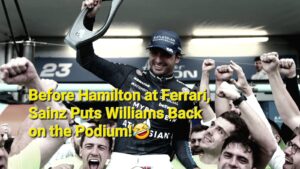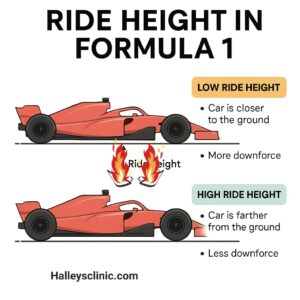Why is Front Wing Design Important for F1 Teams?Miami Grand prix

- by Dr. AK Rana
You would have wondered what exactly is the purpose of Front Wing in formula 1 cars, for sure its not just there to make it look more stylish (HA..HA..HA).
It’s the front wing and it has a very important role to play-
…
Front wing Generates front downforce by pushing front tires onto the track.
Manages and conditions airflow around the car (especially toward the floor, bargeboards, and rear wing).
Crucial for aero balance between front and rear grip.
Physics behind
…
a) Bernoulli’s Principle
Faster airflow = lower pressure; Slower airflow = higher pressure.
…
Front wing is shaped to make air move faster under the wing, causing low pressure below and higher pressure above.
The result is a net downward force (downforce).
b) Newton’s Third Law of Motion
“For every action, there is an equal and opposite reaction.”
Front wing deflects air upward.
In reaction, the car is pushed downward — increasing grip.
c) Angle of Attack
The tilt of the wing relative to the airflow direction.
…
Higher angle = more downforce but also more drag.
Lower angle = less downforce but lower drag.
…
How an F1 Front Wing Is Prepared?
The front wing is the first piece of the car to meet the air, and it plays a huge role in both downforce and aerodynamic balance.
Preparing it is an art that combines engineering, aerodynamics, and track-specific strategy.
1. Track Analysis
Before a race, teams study the circuit:
Does it need high downforce (like Monaco, Japan)?
Or low downforce (like Monza, Bahrain)?
Based on this, they choose the front wing design:
More aggressive (for more grip)
Or flatter profiles (for more speed)
2. Wing Profile Selection
F1 teams have different wing specs ready:
High-downforce wing: More curved elements, deeper angles — gives better cornering grip but more drag.
Low-downforce wing: Flatter, simpler design — reduces drag for higher straight-line speed but compromises cornering.
3. Adjustable Flaps
The front wing has multiple flaps (movable parts).
Mechanics adjust the angle of these flaps (called front wing angle):
Increasing angle = more downforce + more grip in corners.
Decreasing angle = less downforce + higher top speed.
4. Endplates Design
The sides of the wing (endplates) are crafted to control how air flows around the front tires.
5. Y250 Vortex Creation
When air passes through the central part of the wing (around 250 mm from the center), it creates a powerful spinning airflow called the Y250 vortex.
This vortex energizes the airflow under the car, helping to seal the floor and increase downforce.
It’s a crucial reason why front wings are so complex with multiple elements.
…
On-Track Fine-Tuning
During practice sessions, drivers give feedback:
…
“I need more front grip” → mechanics add front wing angle.
“Car is understeering” → again, more angle needed.
“Too much drag” → angle reduced.
Often, one click of front wing change can transform balance mid-session.
In Simple Terms
The front wing is like the “steering wheel” for air.
It controls how much grip the car has at the front and how the airflow feeds the rest of the car.
Teams prepare it like tailoring a suit: custom-fitted to each track, each driver, and each day’s conditions.
Miami Front Wing Setup:
Miami is a street circuit but with some long straights and tricky slow-speed corners.
Think of it as somewhere between Jeddah and Baku:
It needs medium downforce — not as high as Japan (Suzuka), but more than Bahrain or Baku.
For Front Wing in Miami:
Teams go for a balanced front wing setup:
Enough downforce to have grip through the tight and twisty Sector 3 corners (especially that slow, technical section under the highway).
But not so much that it kills top speed on the long back straight (where overtaking happens).
…
The goal is to avoid understeer in the slow corners while keeping speed for the straights.
…
Stay tuned with Halleysclinic.com
Share your thoughts in the comments or reach out at halleysclinic@gmail.com.
Don’t forget to follow our Instagram account https://www.instagram.com/halleysclinic
also read Was Max Verstappen Faster Than McLaren in Jeddah? exclusive physics






1 thought on “Why is Front Wing Design Important for F1 Teams?Miami Grand prix”